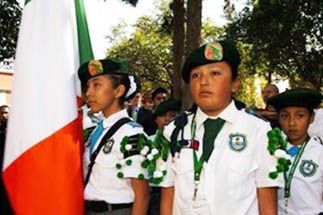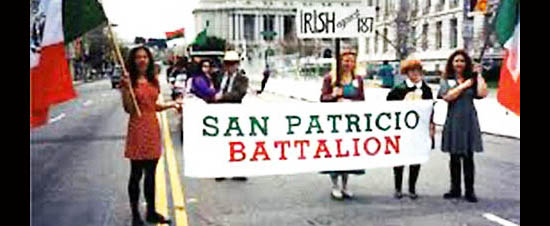The Weekly Bulletin of the Mexico Solidarity Project
March 17, 2021 / Meizhu Lui, for the editorial team

In the 5th century, according to classical history, Saint Patrick drove all the snakes out of Ireland. Centuries later, in the Mexican-American War of 1846-1848, Irish immigrants recruited into the United States Army never succeeded in driving any snakes out of Mexico. But they and their battalion — the San Patricios — succeeded in something much more important. They correctly identified the “snake” in Mexico that so badly needed to be expelled
In the 5th century, according to classical history, Saint Patrick drove all the snakes out of Ireland. Centuries later, in the Mexican-American War of 1846-1848, Irish immigrants recruited into the United States Army never succeeded in driving any snakes out of Mexico. But they and their battalion — the San Patricios — succeeded in something much more important. They correctly identified the “snake” in Mexico that so badly needed to be expelled.
These Irish soldiers arrived in Mexico with orders to force Mexico, at gunpoint, to surrender its territory to the aggressor neighbor. The Irish quickly realized that they were helping to perpetrate a grave injustice. They were being used. They took off their uniforms and joined the Mexicans.
The Saint Patricians recognized snakes when they saw them. In Ireland, British snakes had taken over their land and destroyed the communal system. Its colonial rule impoverished once prosperous Irish farmers. The San Patricios, once in Mexico, saw the stark similarities between their experiences and the lives of Mexican peasants. These Mexicans had waged a revolution just thirty years earlier to defend their communal land. The San Patricios understood the brutality these peasants had faced.
The Irish, with their colonial history, have sometimes been called the only “white of color.” But the Irish migrated to the land of white supremacy, and after a generation Americans of Irish descent fully identified with whites. Enjoying the privileges of being white, many joined in the violence against Chinese immigrants and fought against equal rights for African Americans. In more recent days, many have donned MAGA caps.

But throughout the history of the United States, many Americans of Irish descent have fought for the rights of all workers. They have understood that becoming “white” has a very high price: the loss of Irish identity, an identity of solidarity that transcends racial and national borders.
Bruce Hobson, co-editor of the Bulletin and interviewed for Voices this issue, has Irish roots touching the Saint Patricians. Today, he understands, cross-border movements for justice will only be successful if we all do everything to identify a real snake when we see it. If we don’t, that snake will also poison us.

In the 1970s, when Bruce Hobson worked at a community college, he was greatly influenced by his fellow former Brown Berets (Brown Berets) who were from the Chicano revolutionary movement. In the mid-1980s, she went to work in a peasant-run health program in the mountains of western Mexico, where she cared for disabled children and their families. After giving a workshop to indigenous health workers and representatives of the UN High Commissioner for Refugees in Chiapas, UNHCR hired him to train Guatemalan refugees in orthopedic diagnosis and rehabilitation for children in the Chiapas jungle. After the outbreak of the Zapatista uprising in 1994, the Mexican government deported him, under the pretext that the reason for his work was “to gather international support” for the Zapatista Army.
To read the rest of this exciting bulletin click here!
